| Pages:
1
..
10
11
12
13 |
Laboratory of Liptakov
International Hazard
    
Posts: 1387
Registered: 2-9-2014
Location: Technion Haifa
Member Is Offline
Mood: old jew
|
|
Military NC it may (or may not) contain antidetonation additing. Is necessary (for first attempts) do it itself pure NC 13N+. High quality a very
fine powder AP is condition also. Nitrocelite is of course
alternative primary - secondary material. His detonation pressure is on edge of sensitivity of ETN. But repeatedly works it in my conditions...
Development of primarily - secondary substances CHP (2015) Lithex (2022) Brightelite (2023) Nitrocelite and KC primer (2024)
|
|
|
ManyInterests
National Hazard
   
Posts: 930
Registered: 19-5-2019
Member Is Offline
|
|
I am so sorry. I didn't notice your question. Here is the link where you can get the 8mmODx7mmIDx50mm tubes:
50 Pieces SS304 Material Temperature Sensor One End Closed
If you want a very long tube for an extra powerful detonator here is a where you can get 100 or 200mm versions
Link to long cap
I hope those links work. They might not be available in your country.
|
|
|
Laboratory of Liptakov
International Hazard
    
Posts: 1387
Registered: 2-9-2014
Location: Technion Haifa
Member Is Offline
Mood: old jew
|
|
Nice cavity. And cheap cavity. Thanks for link. Stainless steel is very solid. But for testing brisantion and complette energy is thick the bottom
disadvantage. Deep drawing cavity has thick bottom. EM material in cavity must first overcome
the thick bottom. It can be thick 1mm or more. Therefore final crater (in the lead or normal steel) will halfed, maybe still less. At perpedicular
testing. Hundreds of experiments have confirmed that the highest performance comes from a cavity that has no bottom.. Plus, open output side provide
possibility for easy delaboration in cause failning of the device. The closed bottom is suitable for field conditions and for main charges larger than
50g.
For testing small main charges, for example 10g - 20g, the thick bottom is a disadvantage and can cause the main charge to fail....
Development of primarily - secondary substances CHP (2015) Lithex (2022) Brightelite (2023) Nitrocelite and KC primer (2024)
|
|
|
pjig
Hazard to Others
  
Posts: 169
Registered: 25-5-2010
Member Is Offline
Mood: always learning
|
|
There was an automotive supply for a ss transmission line block. Or radiator plug. It was approximately 7mm and about 2 inches long. Had a perfectly
flat bottom.
With a punch, you concave the bottom for A attractive capsule. But I’m sure it would be cost prohibitive unless you could find bulk online..
LL:
Thank you for the response, on the smokeless powder. That does clarify a couple things.
I will attempt to another go at it with some bull’s-eye, and mill fine AP possibly added dichromate for catalyst.. . In your procedure or you
getting these two items dried on a hot plate or was the hot plate just for the mixing ? if that’s the case, then more acetone was required? I
started off with a NC lacquer and combine that with powder 200mesh AP of which was wetted with acetone, combined and stirred, then rolled into a putty
ball and granulated..
[Edited on 9-4-2024 by pjig]
|
|
|
underground
National Hazard
   
Posts: 702
Registered: 10-10-2013
Location: Europe
Member Is Offline
|
|
Now i have a question but it is out of topic but anyway. What is the most storage, long term, stable primary/secondary ? What would fit best for long
storage caps with ss tubes (except TNT and RDX). I guess ETN is not that much storage stable, PETN is more stable than ETN but still not as much as
TNT/RDX. Ammonium picrate i guess is not suitable for metal cavity. Maybe tetrazole nitrate ? Maybe aminonitroguanidine ? Are complex salts long term
storage stable ? like CHP ?
[Edited on 9-4-2024 by underground]
|
|
|
pjig
Hazard to Others
  
Posts: 169
Registered: 25-5-2010
Member Is Offline
Mood: always learning
|
|
I have found azide and petn to be the holy grail of storage cap combinations.(military standard )=Years of predictable storage. No loss of power and
quality .L ead azide is standard . Petn is very stabile and storable once cleaned up. Not sure why agn3 is so feared . If dextrinated , is very fine
In crystal size and static safe for most part. Just my 2cents
|
|
|
ManyInterests
National Hazard
   
Posts: 930
Registered: 19-5-2019
Member Is Offline
|
|
Quote: Originally posted by Laboratory of Liptakov  | Nice cavity. And cheap cavity. Thanks for link. Stainless steel is very solid. But for testing brisantion and complette energy is thick the bottom
disadvantage. Deep drawing cavity has thick bottom. EM material in cavity must first overcome
the thick bottom. It can be thick 1mm or more. Therefore final crater (in the lead or normal steel) will halfed, maybe still less. At perpedicular
testing. Hundreds of experiments have confirmed that the highest performance comes from a cavity that has no bottom.. Plus, open output side provide
possibility for easy delaboration in cause failning of the device. The closed bottom is suitable for field conditions and for main charges larger than
50g.
For testing small main charges, for example 10g - 20g, the thick bottom is a disadvantage and can cause the main charge to fail....
|
so even 1mm thickness can cause problems... :\ hmm this an issue since I don't know of any other tube that is less than 1mm in thickness. The side
walls are OK but it is the bottom you have an issue with? Like I said, even looking for aluminum tubes (which professional detonators are made of)
they are also 1mm in thickness. Granted I do need to plug the bottom but I have seen people wrap it with aluminum foil to hold in the ETN while they
melt cast it, and when it solidifes it is a solid plug.
My tests with simple handpressed ETN were still very good despite this. But I think I can make it easier by filing off some of the bottom with a file
or an electric tool. It's tedious since I bought many, many of them, but if you say the bottom is too thick, then I'll see if I can remove 0.5mm from
the bottom without uncovering it. That should improve performance.
[Edited on 10-4-2024 by ManyInterests]
|
|
|
Laboratory of Liptakov
International Hazard
    
Posts: 1387
Registered: 2-9-2014
Location: Technion Haifa
Member Is Offline
Mood: old jew
|
|
Your stainless steel is the best cavities for filling of any EM. If you use good pressed ETN, without bottom, you will see incredible holes in steel
plates. Casting is an unnecessary and dangerous operation. You won't gain anything from it. None of my detonators are cast. And look at the beginning
of the thread for exact holes from 0.3g ETN. Or from else EM.....
Development of primarily - secondary substances CHP (2015) Lithex (2022) Brightelite (2023) Nitrocelite and KC primer (2024)
|
|
|
ManyInterests
National Hazard
   
Posts: 930
Registered: 19-5-2019
Member Is Offline
|
|
Quote: Originally posted by Laboratory of Liptakov  | Your stainless steel is the best cavities for filling of any EM. If you use good pressed ETN, without bottom, you will see incredible holes in steel
plates. Casting is an unnecessary and dangerous operation. You won't gain anything from it. None of my detonators are cast. And look at the beginning
of the thread for exact holes from 0.3g ETN. Or from else EM.....
|
So hypothetically. If I cut off the bottom of the tube, and then closed it with a bit of tape to prevent the powder from falling out the end, that
will sufficient?
You've seen the pictures of my results with 0.5g of hand pressed ETN. I've melt-casted ETN into tubes several times before without issue. I take a lot
of care to prevent any issues. I heat the water to only 70C (less will be necessary since the melting point is 60C) and after 7 inches I very
carefully remove it from the water and place it into a holding spot for at least 30 minutes for it to fully solidify.
How will melt-casting not have an effect? My issue previously was that I hard-pressed the initiating mixture. I think my latest test showed a
significant improvement. I am sure if I use melt-cast ETN (as you recommended) mixed with the NHN with only mild tamping I will have the detonator I
am looking for.
|
|
|
Laboratory of Liptakov
International Hazard
    
Posts: 1387
Registered: 2-9-2014
Location: Technion Haifa
Member Is Offline
Mood: old jew
|
|
Why wait 30 minutes when you can have an exit segment in the cavity pressed in 30 seconds. You're just adding work. As you rightly judge, paper tape
is enough. And a small vise. It's 60x faster and safer than casting. // Let's keep things as simple as possible. But not simpler // (Albert Einstein).
Perhaps there was a misunderstanding in the translation. Yes, cast and then crushed ETN must be used for all operations. Per grain 1x1 mm. With a
tolerance of 0.5 mm - 2 mm.
In other words, cast grain....
Development of primarily - secondary substances CHP (2015) Lithex (2022) Brightelite (2023) Nitrocelite and KC primer (2024)
|
|
|
Sir_Gawain
Hazard to Others
  
Posts: 420
Registered: 12-10-2022
Location: Due South of Due West
Member Is Offline
Mood: Like a pendulum
|
|
By cast grain do you mean ETN that's been cast, then broken up into grains? That should form dense, free-flowing grains similar to gunpowder.
“Alchemy is trying to turn things yellow; chemistry is trying to avoid things turning yellow.” -Tom deP.
|
|
|
ManyInterests
National Hazard
   
Posts: 930
Registered: 19-5-2019
Member Is Offline
|
|
OK so I want to make sure I understood everything:
Don't melt-cast the ETN inside the container. Do it outside and grind it back up. Dug Boomfax has a video showing that and I intend to follow it on melt-casting a few grams of ETN at a time using his method. I have some PETN
also, and melt-cast ETN/PETN together can form an extremely brisant mixture that would make for a good detonator charge? But I'll work with the ETN.
Anyway, just melt-cast the ETN then crush it back up. The safest way to do this is to put it on a hot water bath at no more than 60-65C and away from
any heat source so it is in the process of cooling down when the ETN is melt-casting. I remember putting in a few grains of ETN on aluminum foil under
a jet-lighter and it detonated. Thankfully it was only a grain so I got a loud pop and nothing else. After that load it and hand press it as usual. I
was told that ETN that has been processed this way is no more sensitive to friction and pressure than regular powder ETN. Am I right here? I think
with the more compressed melt-cast ETN I can probably fit in 1g into the cap body and still have room for a 0.3g of ETN/NHN mix
But for the detonator body: I've tried plastic and I've tried paper straws (wrapped in electric tape to waterproof) and maybe it is because of
overpressing the mixture, but I just didn't find them effective. When I tried my first metal cap, the results were far better even with the less than
optimal construction methods I used initially. I can probably file away part of the bottom of the 1mm steel caps I use, but I would rather have a
bottomrather these caps with a bottom than without.
|
|
|
Laboratory of Liptakov
International Hazard
    
Posts: 1387
Registered: 2-9-2014
Location: Technion Haifa
Member Is Offline
Mood: old jew
|
|
Do whatever you want, but the open end of the tube gives the best results. When set vertically.....
Development of primarily - secondary substances CHP (2015) Lithex (2022) Brightelite (2023) Nitrocelite and KC primer (2024)
|
|
|
ManyInterests
National Hazard
   
Posts: 930
Registered: 19-5-2019
Member Is Offline
|
|
A very little bottom just to stop things from falling out. 
Edit: I do also want it to set off a few small charges to see if they work. One small 40 or 50g ammonium picrate charge and maybe a 9:1
chlorate/vaseline cheddite charge.
[Edited on 12-4-2024 by ManyInterests]
|
|
|
pjig
Hazard to Others
  
Posts: 169
Registered: 25-5-2010
Member Is Offline
Mood: always learning
|
|
LL
I have to ask if you have attempted a former to concave the bottoms of your compacted foil bases (on caps) attempting a commercial looking /
functioning wave shaping cap. ?
In past I had some luck with short 22 cal empty dented/ concaved in the center to create the wave shaping effect. Glued into an aluminum tube .
Another item I found was some copper cups that fit perfect in a 6mm Al tube. Super Glued in place , A punch was used to indent and concave the base to
create a wave shaper. Very close performance to commercial products. More a valuable asset for shape charge initiation.
[Edited on 14-4-2024 by pjig]
[Edited on 14-4-2024 by pjig]
[Edited on 15-4-2024 by pjig]
|
|
|
Laboratory of Liptakov
International Hazard
    
Posts: 1387
Registered: 2-9-2014
Location: Technion Haifa
Member Is Offline
Mood: old jew
|
|
Yes, but at inner diameter 6 mm is effect Misnay-Schardin minimal. A lot commerce tubes has flat bottom only. Is not serious reason use specials
tools for create concave bottom....
Development of primarily - secondary substances CHP (2015) Lithex (2022) Brightelite (2023) Nitrocelite and KC primer (2024)
|
|
|
pjig
Hazard to Others
  
Posts: 169
Registered: 25-5-2010
Member Is Offline
Mood: always learning
|
|
Yes , agreed . I assume mostly in a shape charge application it would benefit. Most caps I’ve ever delt with that where commercial all had indents
in the base’s
|
|
|
MineMan
International Hazard
    
Posts: 1004
Registered: 29-3-2015
Member Is Offline
Mood: No Mood
|
|
Quote: Originally posted by pjig  | | Yes , agreed . I assume mostly in a shape charge application it would benefit. Most caps I’ve ever delt with that where commercial all had indents
in the base’s |
Not sure I have ever seen one with an indent in the base. We talking about from major companies?
|
|
|
pjig
Hazard to Others
  
Posts: 169
Registered: 25-5-2010
Member Is Offline
Mood: always learning
|
|
All The commercial caps I’ve ever used were concave on the base . Is there a commercial cap with out in the US?
|
|
|
EF2000
Hazard to Others
  
Posts: 153
Registered: 10-5-2023
Location: The Steppes
Member Is Offline
Mood: Taste testing the Tonka fuel
|
|
Just out of curiousity, I decided to run some calculations with compositions from this thread, using ProPEP 3. If you find thermodynamics boring, feel free to ignore me.
For easy comparison I list ideal specific impulse at shifting equilibrium. More information about the program and how to read output can be found
here: http://www.nakka-rocketry.net/th_prope.html#output
Nitrocelite: 202.5 s - NC used in calculation is 13.45% N.
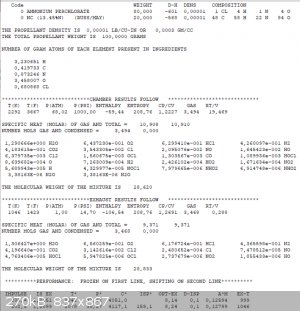
Attachment: Nitrocelite - original.txt (2kB)
This file has been downloaded 101 times
Nitrocelite with more common NC: 205 s - showing that ordinary ~12% nitrocellulose works in propellant as well as highly nitrated 13+% one.
Attachment: Nitrocelite - 12.6N.txt (2kB)
This file has been downloaded 111 times
Nitrocelite with 5% Al: 229.6 s - as always, impulse would be increased only if Al will burn in chamber, not afterwards as sparks.
Attachment: Nitrocelite - 12.6N +5 Al.txt (3kB)
This file has been downloaded 104 times
Lithex: 226.1 s - required adding hexamine to a list of compounds, nice fact: there's no solid products in exhaust, despite metal-containing oxydizer.
Attachment: Lithex.txt (3kB)
This file has been downloaded 106 times
Brightelite: 247.9 s - as expected, AP+hexamine is very good propellant (may I say "impulsive")
Attachment: Brightelite.txt (4kB)
This file has been downloaded 115 times
Conclusion: Nitrocelite is very interesting as a propellant. Since preparation invovles forming a homogenous paste with acetone, it can be formed into
single grain instead of making granules.
Nitrocellulose, either bought or prepared, is much more accessible than usual fuels/binders for APCP, like HTPB or high quality epoxy. And evaporating
acetone is easier than properly curing epoxy.
Since oxygen balance of original nitrocelite (80/20) is +18,4, hence not ideal, I ran calculations for 0 OB mixture (51.2/48.8), then slightly
positive and slightly negative OB, and finally for 50/50 mixture.
0 OB: 247.6 s
+0.544 OB: 246.9 s
-0.153 OB: 247.7 s
50/50 mix: 248.3 s (!)
Attachment: Nitrocelite - 0 OB.txt (3kB)
This file has been downloaded 97 times
Attachment: Nitrocelite - +0.544 OB.txt (3kB)
This file has been downloaded 108 times
Attachment: Nitrocelite - -0.153 OB.txt (3kB)
This file has been downloaded 114 times
Attachment: Nitrocelite 50-50.txt (3kB)
This file has been downloaded 115 times
Of course, ideal proportion for maximum ISP is yet to be determined, but isn't it pretty that 1/1 mixture works well? And calculated specific impulse
is comparable to APCP. For example, according to Nakka's website, popular "Cherry Limeade" APCP gives 225 s delivered ISP (245.2 s calculated).
Attachment: Cherry Limeade.txt (3kB)
This file has been downloaded 122 times
It should be said that PROPEP is a thermochemical code. It doesn't calculate burn rate, can't say whether something will burn at all and will not warn
about dangerously high "pressure exponent" (read as "propensity to CATO"). So if anyone wants to try burning nitrocelite or brightelite in a motor,
even small test motor, they should be very careful.
Edit: it appears that maximum ISP is 249 s at 45/55 AP/NC.
Attachment: Nitrocelite - 45-55.txt (3kB)
This file has been downloaded 117 times
[Edited on 20-4-2024 by EF2000]
Wroom wroom
"The practice of pouring yourself alcohol from a rocket fuel tank is to be strongly condemned encouraged"
-R-1 User's Guide
|
|
|
underground
National Hazard
   
Posts: 702
Registered: 10-10-2013
Location: Europe
Member Is Offline
|
|
Note that NC is not good for propellant as a curing agent since when acetone evapotates many tiny wholes will be created from the evaporated acetone
and it will ruin your burning rate, most likely it will end up with CATO, this is the reason why they use curing agents, then remove the air pockets
in vacume.
Edit: How sensitive is nitrocelite ?
[Edited on 20-4-2024 by underground]
|
|
|
Laboratory of Liptakov
International Hazard
    
Posts: 1387
Registered: 2-9-2014
Location: Technion Haifa
Member Is Offline
Mood: old jew
|
|
Incredible work on Nitrocelite theme....Thanks....But I am afraid that it will CATO....Maybe for ID max. 10 mm it will works....Interestling
countig...
Development of primarily - secondary substances CHP (2015) Lithex (2022) Brightelite (2023) Nitrocelite and KC primer (2024)
|
|
|
EF2000
Hazard to Others
  
Posts: 153
Registered: 10-5-2023
Location: The Steppes
Member Is Offline
Mood: Taste testing the Tonka fuel
|
|
With 80/20 ratio and 13+%N nitrocellulose:
With 45/55 ratio and ~12+%N NC, I guess, it will be lower.
[Edited on 20-4-2024 by EF2000]
Wroom wroom
"The practice of pouring yourself alcohol from a rocket fuel tank is to be strongly condemned encouraged"
-R-1 User's Guide
|
|
|
pjig
Hazard to Others
  
Posts: 169
Registered: 25-5-2010
Member Is Offline
Mood: always learning
|
|
It seems amazing that military is able to utilize Rdx and other highly energetic materials in propellants( rockets and guns) and not get a detonation.
Certain modifiers will be required, but it can be done under right conditions.
Well on the note of composite materials….. cast nitrocelite may have a high destiny, and nice VOD v.s. Granular material packet in cartridges.
Probably in the 5k+ range
|
|
|
Laboratory of Liptakov
International Hazard
    
Posts: 1387
Registered: 2-9-2014
Location: Technion Haifa
Member Is Offline
Mood: old jew
|
|
Since there was an attempt to test a the detonator on lead in another thread, I'm attaching some lessons learned here. In Fig. 1 we see
basic assembly for the experiment. Detonator is create from cavity 8/6 50 mm structural steel. With 300 mg ETN pressed on 30 Kg. And also the
filament strung on the through mandrel, which is used in the final pressing of the detonator. As a secondary target was used also construction steel
2mm of thickess, also used repeatedly in older else attepts. Basic brick from casted Lead is in role of main target.
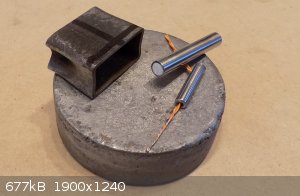
On fig. 2 and 3 is assemble ready to attempt. Lesson learned: before attempting it is important to take a picture of the whole assembly before firing.
Because the viewer has no idea what the detonator looks like and its location.
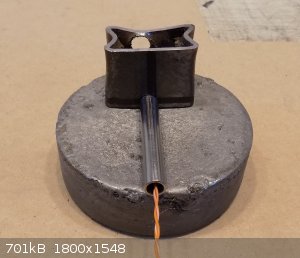 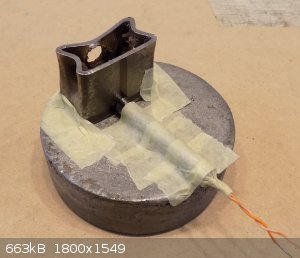
On Fig. 4 you can see damage, which cause detonator on both targets. And also bigger chip from detonator itself. On inside chip of detonator is see
copper surface, which was created from detonation of CHP. Steel of 1 mm thickess is after blow only 0,5 mm.
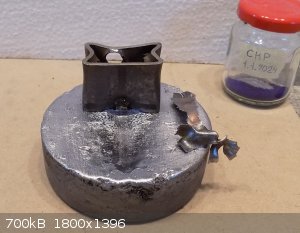
Fig.5 and Fig 6:... Here we can see huge energy, which comes out from detonator on perpendicular bottom. On the contrary, the energy that is
discharged into the lead is almost negligible. Lesson learned: Testing detonators so-called flat is a waste of time and material. And it does not
bring a clear, rather almost no result to the researcher.
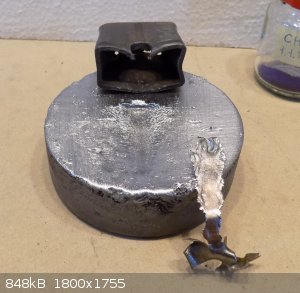 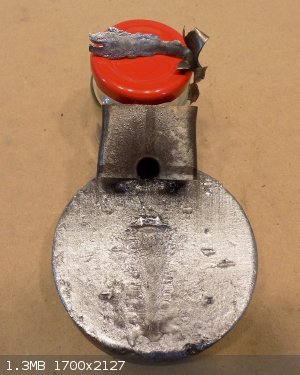
Fig.7......Is repeatedly see detonation pressure of ETN in perpendicular direction. Which damaged also secondary steel on profile 2 mm. Contrary, on
the lead brick we can see only a deeper scratch. However, lead can have the advantage of capturing the distribution of energy that rises from
approximately the middle of the detonator to its exit end. Which was supported by a steel profile. Arises almost photography stread of energy of
detonation.
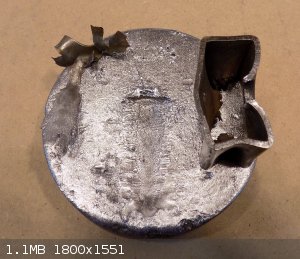
Filling of detonator how was sayed, output segment 300 mg ETN/30 Kg, medium segment 0,1 ETN + 0,1 CHP /1 Kg, starting segment 0,3 CHP / 1 Kg pressed.
Plug created from classic grain BP cca 0,1 g pressed on 5 Kg. Bridge wire supply 12V / 2 A............
Development of primarily - secondary substances CHP (2015) Lithex (2022) Brightelite (2023) Nitrocelite and KC primer (2024)
|
|
|
| Pages:
1
..
10
11
12
13 |